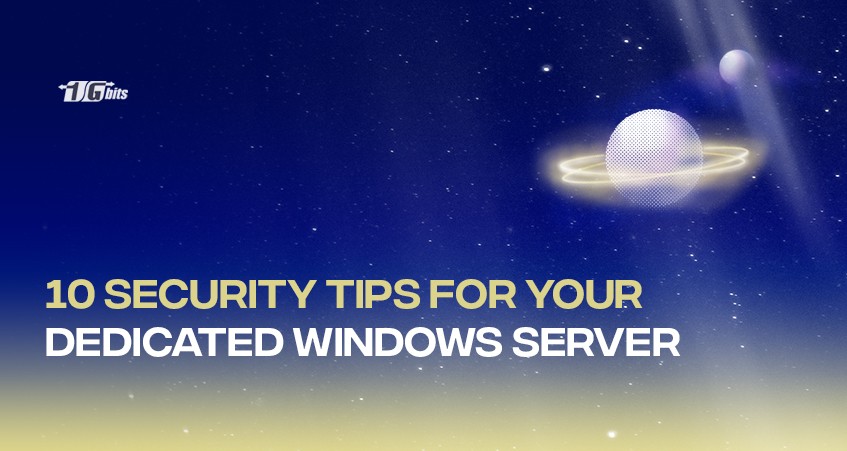Strengthen your online presence with a secure foundation – purchase a dedicated server and follow these 10 essential security tips to keep your Windows Server safe from cyber threats.
Today most people are using dedicated Windows servers individually or for business purposes. Due to high demand, irrespective of the size of the business, maintaining and ensuring high-end security for the Windows server has become more critical. It is essential to secure crucial performance and business information from thefts and hackers.
The Windows server has already taken several security measures in place to ensure the high-end security of every individual and its components. Before storing or transferring your data to the server, ensure that you implement the proper procedures to keep the data safe. We have mentioned some of the best security tips to ensure sufficient defence against most potential threats.
1. Update your Windows server timely
Suppose you are still running your business with the older image of the Windows server. It becomes necessary that you update your dedicated server with the latest security patches and performance updates. Install the patches without affecting your server’s work. Mostly, the latest server installs come with the appropriate defence mechanism and standards to safeguard your server from unexpected malicious attacks.
If you have recently set up your Windows server, make sure to do it with the latest image available on Microsoft. You can take out the right time to start the latest installation on your server and update the security features accordingly.
2. Always install the important OS components from the Windows server core
From Windows Server 2012 and above, you can seamlessly use the available core mode to work on the operating system. This core mode allows you to install only minimal options without the requirement of the GUI, resulting in fewer features.
If you install the Windows server code, you can see the difference in its performance. Also, you can use the same hardware to get improved performance through unutilized OS components. It will cut down the RAM and CPU requirements, ensure high and guaranteed uptime and boot time, and require fewer patches.
While you enjoy the performance, you can also leverage high-end security. Working on the server containing fewer resources, tools, and endpoints to attack makes it more challenging for the attackers to enter your server. The hackers will get less attacking due to the lack of GUI-based OS.
3. Protecting the admin accounts
Whenever you create a user account within the dedicated server, it is named Administrator by default. Due to the admin account having the maximum access to the server and can implement any change at any point within the server; thus, the admin accounts need to be protected. It increases the chances of more brute force attacks on this account.
To achieve this, you can rename the admin account to something else, reducing the chances of an attack on this account. Another option is to disable the local administrator account and create a new one. After you disable the local admin account, check for the availability of the local guest account. Local guest accounts are one of the least secure accounts, so make sure that you use them wherever possible.
4. NTP Configuration
This configuration ensures that your server will be synced as per the NTP (Network Time Synchronization) servers to prevent clock drift. It is considered an essential factor, as a few minutes of difference can prevent unauthorized Windows login.
Many companies use network devices using internal clocks for synchronization. Some servers sync their time using the domain controller. At the same time, some stand-alone servers require the setting up of the NTP to an external source to protect the server from external attacks.
5. Enable and Configure Windows Firewall and Antivirus
In general, the Windows server comes with a firewall and antivirus tools by default. If your server does not have the required hardware firewall, you can use the Windows firewall to reduce the attack surface.
Not only this, you will get decent protection against malicious attacks and cyber attacks, as it narrows down the pathways for the incoming traffic. If you want to implement a high-end security system, you can go for the hardware-based or cloud-based firewall, as it takes most of the load off your server.
You can also create some firewall rules for ensuring security. If you want to configure the firewall, it might be challenging as it requires expertise. If you do not configure it correctly, it will open doors for the attackers, and your server will be at high risk.
6. Secure Remote Desktop (RDP)
If you are connecting to the server using the remote desktop protocol, make sure that it is not exposed to everyone on the network. For limiting the usage to unauthorized access, you need to change the default port.
If you're looking for secure and reliable remote desktop access, consider exploring RDP servers, which offer enhanced security features and performance for managing your dedicated Windows server efficiently.
Also, make sure you restrict the RDP access to some IP addresses only. If you do not set the properties, such as who can access it, it will be open to all by default, making it more prone to attack.
You can implement other standard security practices to keep the RDP secure, such as a strong password for your account, implementing two-factor authentication, updating the software constantly, restricting unwanted access via firewalls, and others.
7. Enabling the BitLocker Drive encryption
BitLocker is one of the commonly used encryption tools that are built-in with the server edition of the operating system. It is the topmost implemented security measure as you can use it to encrypt the entire hard drive even when your server’s physical security has been breached.
While encrypting, the Bitlocker uses your computer’s information to verify your server’s authenticity. After the server verifies the information provided by the user, the user can use their password for logging into your computer. If there is any unwanted access, the BitLocker will ask you for the recovery key.
If the user cannot provide the decryption key, the computer will not unlock it. It is one of the best ways to ensure your server’s security.
8. Using Microsoft baseline security analyzer
Some tools are for developers, while the IT professionals use some without coding knowledge. Such an effective tool is the Microsoft Baseline Security Analyzer (MBSA) which is freely available for every user.
This tool can find potential security issues and provide suitable remediation by keeping Microsoft’s security standards in mind. It helps IT professionals manage the security of their Windows servers. If you are using the MBSA tool, it will help you find the weak points within your server that can severely impact your server’s security.
Such weak points could be weak passwords, missing system updates, IIS vulnerabilities, etc. It will use the IP address and domain for scanning the network systems. At last, this tool will create a detailed report specifying all the issues using the GUI in HTML.
9. Configure Log Monitoring and Disable Unnecessary Network Ports
If you want to be a pro in managing and maintaining an excellent smooth server, you must take care of settings within your server that will take off its load. Ensure that you disable all the services and protocols installed on your windows server whenever it is not in use.
To achieve this, you can run a regular scan on your server to check that services within the network are most exposed to threats. Once you know what services are a severe threat, you can immediately prevent vulnerabilities.
You can prevent intrusion by consistently monitoring the login attempts on the server so that you can prevent brute-force attacks. You can also implement dedicated intrusion prevention tools to review all the logs and send notifications if any malfunction is detected. Once the respective teams get the alerts, they can take appropriate actions to prevent the attack and ensure instant security.
In addition to monitoring login attempts and implementing intrusion prevention tools, using Network Monitoring Software for Windows can provide an extra layer of protection. This software allows you to keep an eye on network traffic, identify unusual activity, and ensure your server's security in real time.
10. Reducing the attack vector
You can also ensure security by reducing the acting vector of the server, which means you can reduce all the unnecessary services from the server. If you have the bare minimum services, the attacker will not get the loose end to enter your server and impact its working. So keep a check on your system for the necessary and unnecessary services used on your system.
Conclusion
Dedicated Windows servers are most commonly used in the market due to their ease and efficiency in managing each application and project. But, with every benefit comes the downside. One significant consideration is the dedicated server pricing, which can vary greatly depending on the specifications and services offered by different providers. Understanding these costs is crucial for businesses to make informed decisions and optimize their IT budgets effectively.
The Windows server can be at risk of security as it connects thousands of systems and stores millions of data, making it more prone to attackers. To ensure complete security, you can take the best measures at your disposal without being technically strong. We have mentioned some security tips that a beginner can quickly implement. So take precautionary measures and safeguard your data.
For those looking to enhance their security while ensuring optimal performance, Buy Dedicated Server Hosting. This option provides you with exclusive resources and greater control over your server environment, allowing you to implement robust security measures tailored to your specific needs. Investing in dedicated server hosting can be a game-changer in protecting your data and maintaining the integrity of your systems.
For budget-conscious businesses, exploring Cheap Dedicated Servers can offer a cost-effective solution without compromising on essential security features and performance.
People also read:








